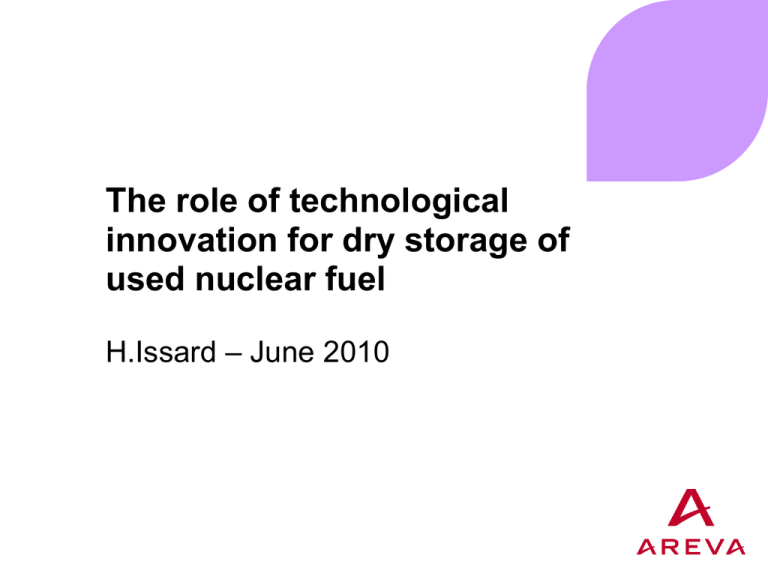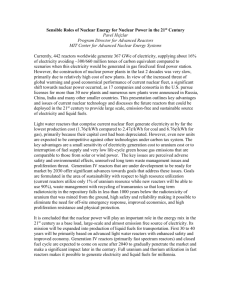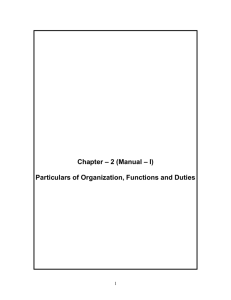France 1 - Nuclear Safety and Security
advertisement

The role of technological innovation for dry storage of used nuclear fuel H.Issard – June 2010 Summary The innovation mandate Mission & Objectives Key performances Innovation areas Innovation process Main steps of the Process Methods & tools for innovation Examples of Innovations Conclusion International conference on management of spent fuel from nuclear power reactors– June 2010 innovation mandate Mission and objective Innovation is a keystone for the strategy of the back end, Need to integrate evolutions and New technologies Nuclear utilities needs evolve Additional payload, acceptance of higher discharge burnups and easier licensing process Key performances Storage capacity and economical performance Safety and ease of licensing Ease of operation and reduction of doses of operators Impact of selected technology on sustainable development Impact of selected technology on proliferation issues International conference on management of spent fuel from nuclear power reactors– June 2010 innovation areas Storage equipment design Cost, capacity, flexibility of the storage system Interfaces for handling, loading and transfer Tie down designs Quick evacuation procedure Justification methodology Modelisation Knowledge of safety margins Material behaviour for longer periods Damaged fuels International conference on management of spent fuel from nuclear power reactors– June 2010 innovation process Innovation process Perform regular interviews with customers and utilities Access, capture and reuse of experience feedback and knowledge Creativity and idea generation Screen ideas for added value Selection of ideas and R&D plan Factors of success Participatory innovation : creation, collaboration, communication Involvement of everyone, including top management incentives International conference on management of spent fuel from nuclear power reactors– June 2010 Innovation process , methods AREVA logistics open space of innovation : ID school Initiatives : creativity groups Express ideas through drawings, models Creative ambiance, develop participatory innovation International conference on management of spent fuel from nuclear power reactors– June 2010 Innovation process, methods Methods to galvanize innovation Brainstorming, Triz, etc Creativity method developed by AREVA : method EFICA ® Every step is the result of a divergent and a convergent phase E EXPLORE (Exploration, Impregnation): Identify all the aspects of the problem without paying too much attention to the aspect which brought the problem to light; look at it from all angles without any prejudices or preconceived ideas, become immersed in it and take it on board F FORMALIZE (Expression, Analysis, Formulation, Incubation): I IDEAS (Creation, Ideas, Enrichment, Inspiration) : Analyze and structure in detail the formulation of the problem and all its components and break it down into targeted areas of research; specify objectives, requirements and selection criteria Put together and produce for each area of research a large number of solutions and original ideas; deepen and enrich ideas C CONSTRUCTION (Prioritization, Choice, Valorisation): : A ACTION (Application, Organisation, Action Plan) : Range, prioritize, select ideas following the previously defined selection criteria; combine and enrich ideas (cross-fertilization) For any solution, build an action plan, i.e. a program with detailed facts and figures for implementation International conference on management of spent fuel from nuclear power reactors– June 2010 Tools for innovation Tools for management of ideas Ideas are welcome Idea management data bank (example ID HALL) Regularly, a committee evaluates each new idea: Apply Stand by Rejected International conference on management of spent fuel from nuclear power reactors– June 2010 Examples of Innovations Baskets : High performance design solutions for sub-criticality Trend towards high burn-ups for LWR fuels ( 60 000 MWd/tHM for the EPR) higher fissile contents = higher U-235 enrichments (5%) or higher plutonium contents for MOX. Sub-criticality is guaranteed by the basket geometry and the material. real challenge to design high capacity baskets. Use of a family of borated alloys : Borated stainless steel plates or Metal matrix composites, formed by casting, powder metal processes. All characteristics (composition, mechanical) have been studied, including the homogeneity of Boron content and the resistance to corrosion in borated water; they are satisfactory. Boralyn™ with 15% B4C is an example of high performance materials for sub-criticality: it can be used for the structural resistance of the baskets. There is also the new Boron Metal Matrix Composite (MMC) material with an aluminium matrix and up to 25% B4C. International conference on management of spent fuel from nuclear power reactors– June 2010 Examples of Innovations Innovation in containment A new type of fluorocarbon O-ring gaskets has been developed and qualified to keep the guaranteed leak rate for a large range of temperatures -40°C to 200°C. The long term behaviour at high temperature of EPDM O-ring gaskets has been studied with innovative methodology , to establish time-limit versus temperature for EPDM O-rings. International conference on management of spent fuel from nuclear power reactors– June 2010 Examples of Innovations Mitigation of hydrogen risk For the mitigation of hydrogen risk in the cavity of casks, several catalytic recombiners have been developed and qualified, with a sufficient capacity to stabilise the hydrogen concentration bellow the flammability limit. In cooperation with French research institute IRCELYON. Recombiner (dry conditions) Recombiner dry /wet International conference on management of spent fuel from nuclear power reactors– June 2010 Box for recombiners Examples of Innovations Complete range of high performance neutron shielding materials TN has developed high performance neutron shielding materials resisting to fire tests (self extinguishing) : TN® VYAL B, TN® HYPOP and TN® BORA for subcriticality. These materials are adapted to different thermal environments and can be selected depending the temperature of use. Solutions for thermal and structural management For a given metallic containment vessel containing a given number of used fuels, the necessary thickness of neutron shielding material increases when Burnup of fuel increases. Innovation : a better heat evacuation system to compensate the negative effect of thermal insulation of neutron shielding material (polymers are generally low heat-conductive materials) : thermal conductors, fins, special surface treatments, and minimizing gap between cask inner wall/basket . International conference on management of spent fuel from nuclear power reactors– June 2010 Examples of Innovations Spent fuel dry storage systems TN®DUO Storage Transport International conference on management of spent fuel from nuclear power reactors– June 2010 Examples of Innovations Spent fuel dry storage systems TN®NOVA Cannister Overpack transport cask International conference on management of spent fuel from nuclear power reactors– June 2010 Conclusion The role of innovation for the management of used fuel is to bring important benefits in term of performance, safety and public acceptance. With innovation, the nuclear industry, and especially the back end is looking towards the long term and engaged in preparing a future with less CO2 emissions. International conference on management of spent fuel from nuclear power reactors– June 2010








![The Politics of Protest [week 3]](http://s2.studylib.net/store/data/005229111_1-9491ac8e8d24cc184a2c9020ba192c97-300x300.png)


